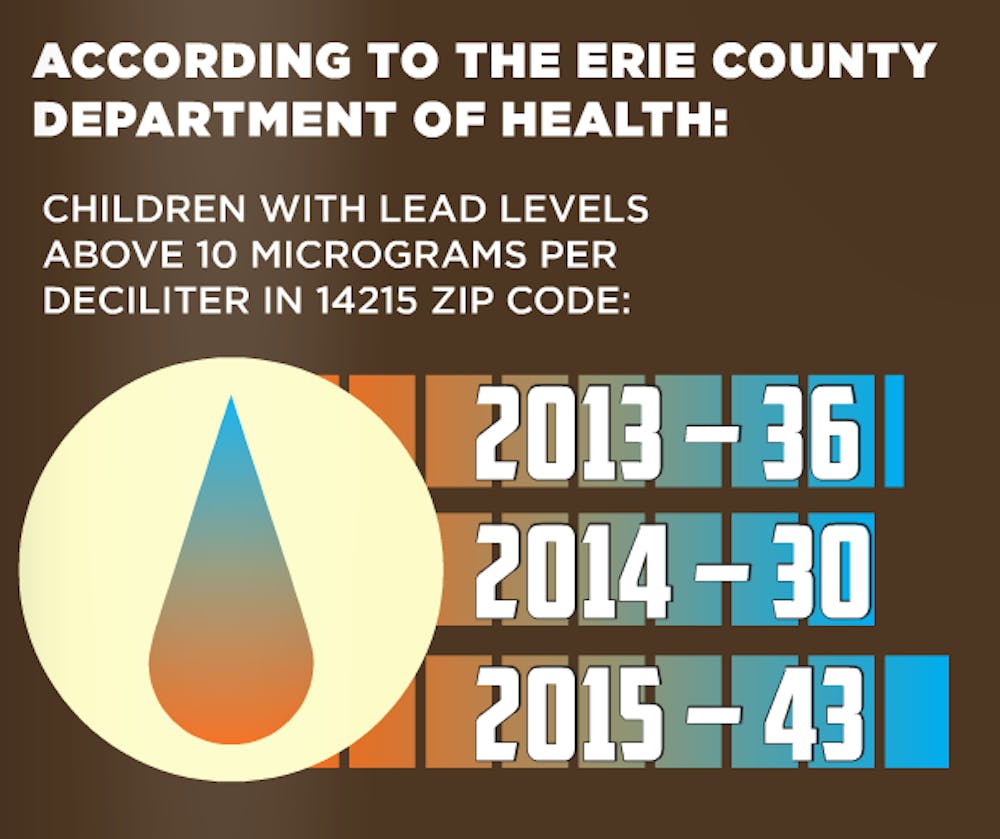Paint chipping and dust in some University Heights homes may cause lead poisoning.
More than 100 children living in the zip code 14215 – which includes the University Heights – have had elevated blood-lead levels from 2013-15, according to the Erie County Department of Health.
Lead poisoning can cause damage brain development and lower IQ in children six years or younger, according to Dr. Gale Burstein, Erie County Department of Health Commissioner.
Burstein said students and faculty living in the Heights, the neighborhood located off South Campus, are unlikely to be susceptible to lead poisoning unless their home undergoes renovations.
Carly Kaminsky, a senior communication major who has also lived in the Heights for two years, doesn’t feel lead poisoning is much of a concern for students, but they should contact their landlords if problems arise.
“Lead is definitely scary with the Flint crisis but I don’t think students should worry as long as they keep in contact with their landlords,” Kaminsky said.
Until 2012, the Centers for Disease Control (CDC) referenced a “level of concern” when a child had 10 or more micrograms per deciliter of lead in their blood. According to the CDC’s website, experts now use a reference of five or more micrograms per deciliter for children age one to five after being exposed to lead.
The CDC changes this number every four years by reanalyzing the blood from four years previous to current blood-lead distributions in children.
From 2013-15, 109 children in the zip code 14215 have confirmed blood-lead elevations of more than 10 micrograms per deciliter, the Erie County Department of Health’s benchmark for “levels of concern.”
Unlike the recent lead situation in Flint, Michigan, the main cause of lead poisoning in children in Buffalo is not tap water, but the ingestion of lead from paint chips and dust.
The United States Environmental Protection Agency requires a special certification “for all home improvement activity in housing built before 1978 and in any child occupied facility.”
Earlier in March, Erie County Executive Mark C. Poloncarz announced a commitment of $3.75 million over the next five years to increase lead inspections and remediation across Erie County.
Burstein said the funding would critically strengthen Erie County’s efforts to decrease lead poisoning and help more homeowners and landlords recognize and ameliorate their lead problems.
In comparison to 4 percent of children in Flint, Michigan, 13 percent of Western New York children tested positive for lead poisoning, according to the CDC. Erie County had the highest rate among the four counties of Western New York.
The chances of a UB student having elevated levels of lead in their blood is very unlikely according to Melinda Cameron, clinical assistant professor in the Department of Pediatrics.
“The danger would be if renovation was being done,” Cameron said. “In an older city with older housing like Buffalo, people still need to be aware that there are health hazards, especially if you have children.”
UB faculty, and perhaps their children, however, are moving into the Heights under UB’s new incentivized H.O.M.E. program, which provides loans for faculty buying homes in the neighborhood.
“Kids have a lot of hand-to-mouth activity and that is where the problem begins,” Cameron said.
Treatment for lead poisoning is difficult because the only way to find out if a child has the condition is to undergo blood work. There are no symptoms of lead exposure unless they reach extremely high levels.
These high lead levels in children can cause severe neurologic problems such as coma, convulsion and even death, although such levels are now rare in the United States, according to the CDC.
There is no medical treatment to permanently reverse the adverse health effects of lead exposure in children, according to the Department of Health, and a child’s levels must reach more than 45 micrograms per deciliter for any kind of treatment to be effective.
Of the 110 children testing positive for lead elevations in the 14215 area code, almost half had enough to require more in-depth reviews for treatment according to Dan Ryan, director of Off-Campus Student Services.
Some students that live in the area don’t see it as much of a problem as long as they keep up with the maintenance of their home.
Sam Ackerman, a senior accounting major, has lived in the University Heights area for two years. He said the higher rates of lead aren’t too much of a worry for him.
“Its obviously dangerous if paint is chipping, but if you maintain care of your home you won’t run into an issue of lead poisoning,” Ackerman said.
Evan Schneider is the news editor and can be reached at news@ubspectrum.com.





